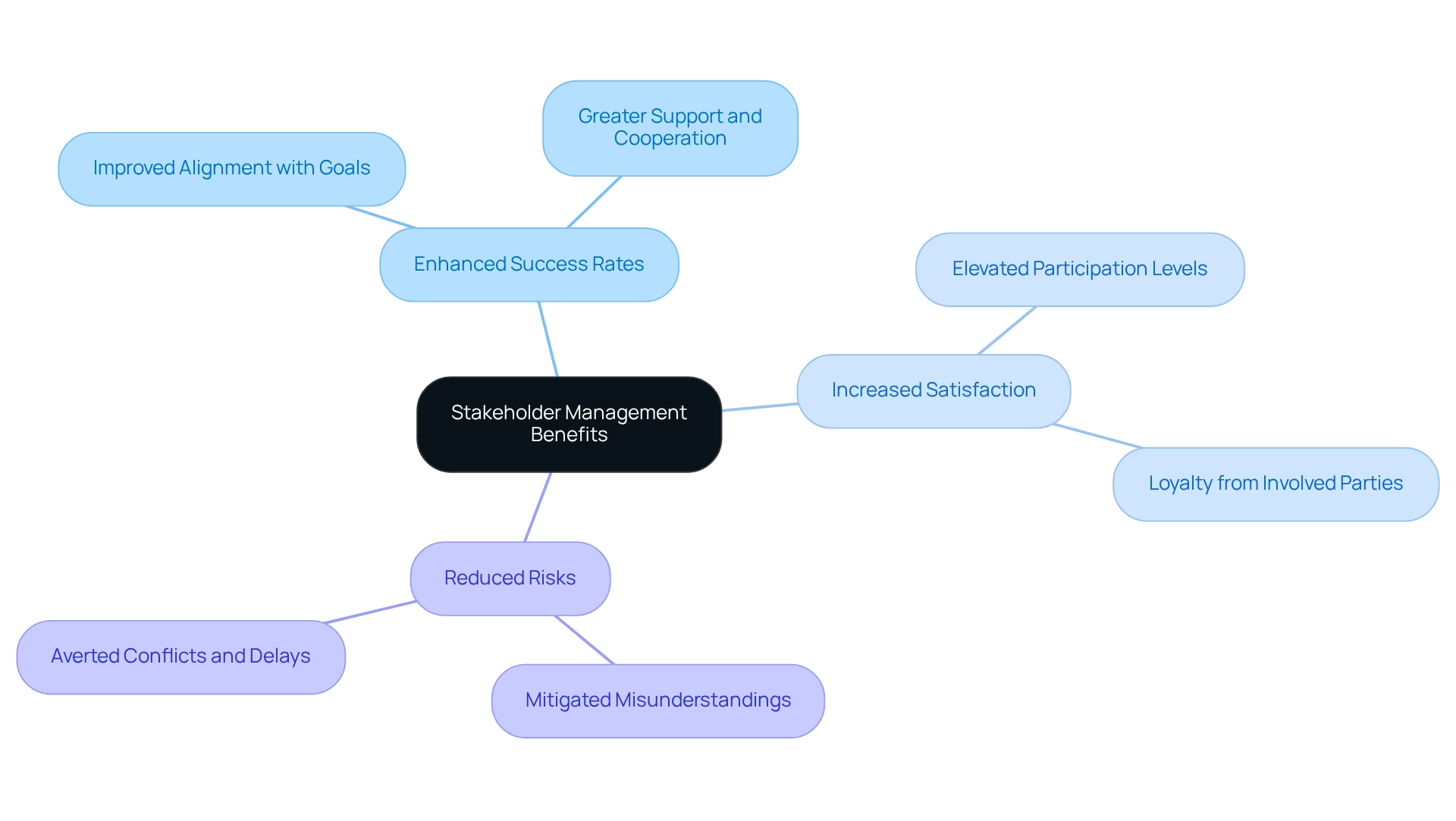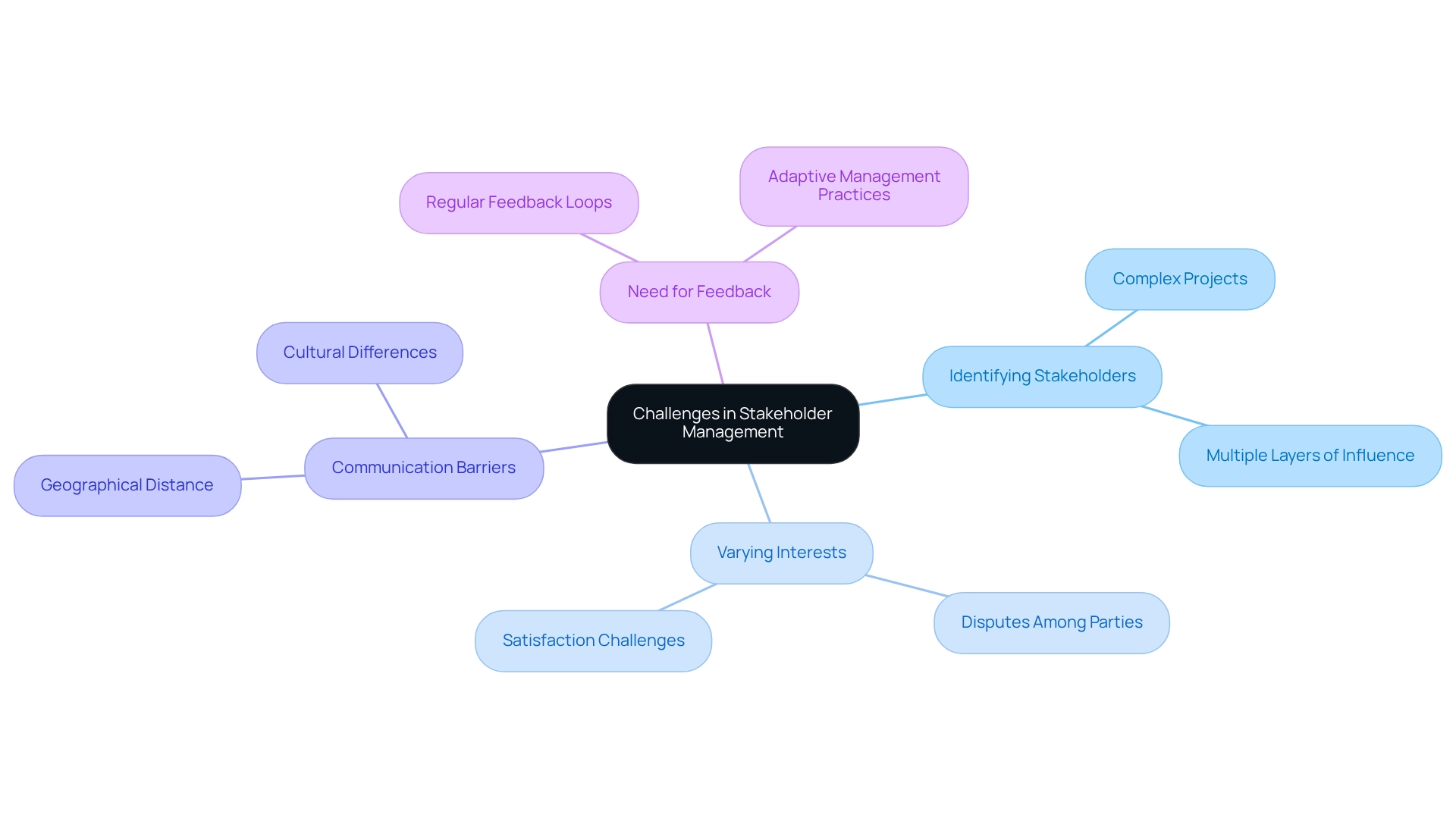Overview
Stakeholder management is a systematic process that encompasses the identification, analysis, and engagement of individuals or groups with an interest in or impacted by an organization's initiatives. This process is essential for cultivating robust relationships and aligning with organizational objectives. The article underscores this importance by detailing the critical components of stakeholder management, including:
- Engagement strategies
- Continuous oversight
These elements are pivotal in enhancing project success rates and mitigating risks through effective communication and a comprehensive understanding of stakeholder needs.
Introduction
In the intricate web of modern business, stakeholder management stands as a vital discipline that shapes the success of projects and organizations alike. This systematic approach involves identifying, analyzing, and engaging with individuals or groups who hold a vested interest in a project, ensuring their needs and expectations are met. As businesses evolve, so too does the understanding of stakeholder dynamics, transitioning from a focus on shareholders to a more inclusive strategy that embraces employees, customers, and the broader community.
This article delves into the significance of effective stakeholder management, tracing its evolution, identifying key components, examining its benefits, and addressing the challenges organizations face in fostering meaningful relationships. By mastering these elements, organizations can not only enhance project outcomes but also cultivate lasting connections that drive sustainable success.
Define Stakeholder Management and Its Significance
The definition of stakeholder management is a systematic process that involves identifying, analyzing, and engaging individuals or groups with an interest in or impact from an initiative or organization. Understanding their needs, expectations, and potential impact on project outcomes is crucial.
The definition of stakeholder management emphasizes that effective management of these interested parties fosters strong relationships, enhances communication, and ensures alignment with organizational goals. By initiating each client interaction with a comprehensive organizational review, organizations can gain deeper insights into their situation beyond mere numbers. This approach simplifies decision-making and enables real-time analytics.
Moreover, this proactive method aids in recognizing fundamental business concerns while bolstering strengths, ensuring that stakeholders are engaged in a meaningful way. By actively managing involved parties, organizations can apply the definition of stakeholder management to reduce risks, prevent conflicts, and enhance overall project success rates. Ultimately, applying lessons learned cultivates strong, enduring relationships.

Trace the Evolution of Stakeholder Management
The concept of stakeholder oversight traces its roots back to the early 20th century, gaining significant attention through R. Edward Freeman's influential work in the 1980s. In his seminal book, 'Strategic Management: A Stakeholder Approach,' he introduced the term 'interested party,' which shifted the focus of oversight primarily towards shareholders and financial outcomes.
However, as businesses began to recognize the importance of social responsibility and ethical practices, the scope of oversight expanded to include a diverse range of stakeholders, such as:
- employees
- customers
- suppliers
- the broader community
Today, the definition of stakeholder management is a critical component of strategic planning and decision-making processes, reflecting a more holistic approach to business management.

Identify Key Components and Processes in Stakeholder Management
Key elements of the definition of stakeholder management encompass identification, analysis, engagement, and monitoring. This process begins with the crucial step of identifying interested parties, which is essential to the definition of stakeholder management, involving recognizing all individuals or groups that may influence or be influenced by the project.
Following this, an analysis based on the definition of stakeholder management is conducted for these parties regarding their interests, influence, and potential impact. Subsequently, engagement strategies are developed to ensure effective communication with interested parties, addressing their needs and concerns comprehensively.
This engagement process is intricately linked to a thorough organizational review, which aids in uncovering underlying issues and aligning key participants with the organizational context beyond mere figures. Moreover, continuous oversight and assessment of partner relationships are vital for adjusting strategies as necessary and maintaining alignment with organizational objectives.
Instruments such as participant maps and engagement plans are frequently utilized to facilitate this process, enabling efficient decision-making and real-time analytics that enhance business recovery and performance tracking.

Examine the Benefits of Effective Stakeholder Management
The definition of stakeholder management highlights that efficient oversight of involved parties presents significant advantages, including:
- Enhanced success rates
- Increased satisfaction among participants
- Reduced risks
By fostering strong connections with stakeholders, organizations can ensure improved alignment with project goals, which reflects the definition of stakeholder management, leading to greater support and cooperation. Moreover, effective communication clarifies expectations and mitigates misunderstandings, which can avert conflicts and delays.
Organizations that prioritize the definition of stakeholder management often witness elevated levels of participation and loyalty from involved parties, ultimately contributing to long-term success and sustainability. For instance, companies that actively engage with their customers and employees typically experience enhanced innovation and responsiveness to market changes.

Challenges in Stakeholder Management
The definition of stakeholder management involves managing involved parties, which presents several challenges that cannot be overlooked despite its benefits. One prevalent issue is the difficulty in recognizing all pertinent parties, particularly in complex projects characterized by multiple layers of influence. Moreover, the varying interests of these parties, as outlined in the definition of stakeholder management, can lead to disputes, complicating efforts to satisfy everyone engaged.
Communication barriers, whether stemming from geographical distance or cultural differences, further hinder effective engagement. To address these challenges, organizations must invest in a comprehensive analysis of interested parties, aligning with the definition of stakeholder management, and develop clear communication strategies tailored to meet the unique needs of each group.
Regular feedback loops and adaptive management practices are essential to enhance stakeholder relationships and improve project outcomes.

Conclusion
Effective stakeholder management stands as a cornerstone of contemporary business strategy, cultivating robust relationships and aligning organizational objectives with stakeholder expectations. By systematically identifying, analyzing, and engaging stakeholders, organizations can mitigate risks, enhance communication, and ultimately elevate project outcomes. The shift from a shareholder-centric approach to a more inclusive stakeholder model underscores the increasing emphasis on social responsibility and ethical practices within the business landscape.
Key components, including stakeholder identification, engagement strategies, and ongoing monitoring, are essential for navigating the complexities inherent in stakeholder relationships. These processes not only streamline decision-making but also ensure that stakeholders are meaningfully involved, fostering increased satisfaction and loyalty. However, challenges such as identifying all relevant stakeholders and managing divergent interests can complicate effective engagement.
In conclusion, prioritizing stakeholder management is not merely advantageous; it is imperative for attaining sustainable success in today’s interconnected world. Organizations that embrace this discipline will find themselves better positioned to foster collaboration, drive innovation, and adapt to evolving market dynamics, thereby securing a competitive advantage. As businesses continue to evolve, the commitment to understanding and addressing stakeholder needs will remain a cornerstone of effective management and long-term viability.
Frequently Asked Questions
What is stakeholder management?
Stakeholder management is a systematic process that involves identifying, analyzing, and engaging individuals or groups who have an interest in or are impacted by an initiative or organization. It focuses on understanding their needs, expectations, and potential impact on project outcomes.
Why is effective stakeholder management important?
Effective stakeholder management fosters strong relationships, enhances communication, and ensures alignment with organizational goals. It helps organizations engage stakeholders meaningfully, reducing risks, preventing conflicts, and enhancing overall project success rates.
How can organizations gain insights into their stakeholders?
Organizations can gain deeper insights into their stakeholders by initiating client interactions with a comprehensive organizational review. This approach goes beyond mere numbers, simplifying decision-making and enabling real-time analytics.
What historical context is important for understanding stakeholder management?
The concept of stakeholder management gained significant attention in the 1980s through R. Edward Freeman's work, which introduced the term "interested party." This shifted the focus from primarily shareholders to include a broader range of stakeholders, such as employees, customers, suppliers, and the community.
How has the definition of stakeholder management evolved over time?
The definition of stakeholder management has evolved to reflect a more holistic approach to business management, expanding from a focus on financial outcomes to include social responsibility and ethical practices, thereby incorporating a diverse range of stakeholders.




